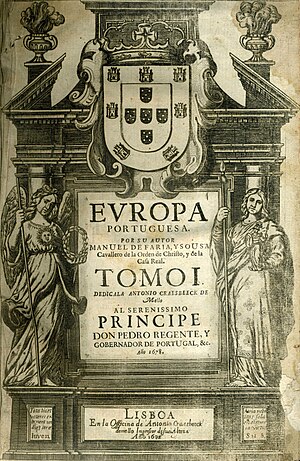Manuel de Faria e Sousa (Portuguese pronunciation: [mɐnuˈɛl dɨ fɐˈɾiɐ i ˈsozɐ]; Spanish: Faria y Sousa; 18 March 1590 – 3 June 1649) was a Portuguese historian and poet who frequently wrote in Spanish.[1]

He was born into a Portuguese noble family and studied in Braga for some years before entering into the service of the Bishop of Porto. Except for about four years, from 1631 to 1634, during which he was a member of the Portuguese embassy in Rome, the greater part of his later life was spent in Madrid, where he died in June 1649.
He was married to Catarina Machado, the "Albania" of his poems, which enabled him to lead a studious domestic life, dividing his cares and affections between his children and his books. His first big work, an Epitome de las historias Portuguezas (Madrid, 1628), was favorably received; but some passages in his enormous commentary upon the Portuguese epic Os Lusíadas, the poem of Luís de Camões,[2] excited the suspicion of the inquisitors, caused his temporary incarceration, and led to the permanent loss of his official salary. Despite the enthusiasm that is said to have prescribed to him the daily task of twelve folio pages, death overtook him before he had completed his hugest enterprise, a history of the Portuguese in all parts of the world.
Several portions of the work appeared at Lisbon after his death, under the editorship of Captain Faria e Sousa : Europa Portugueza (1667, 3 vols.); Ásia Portugueza (1666–1675, 3 vols.); África Portugueza (1681). As a poet, Faria e Sousa was nearly as prolific; but his poems are vitiated by the prevailing Gongorism of his time. They were for the most part collected in the Noches claras (Madrid, 1624–1626), and the Fuente de Aganipe, of which four volumes were published in Madrid in 1644–1646. He also wrote, from information supplied by P. A. Semmedo, Imperio de China i cultura evangelica en l (Madrid, 1642), and translated and completed the Nobiliário of the Count of Barcelos.
There are English translations by J. Stevens of the History of Portugal (London, 1698), and of Portuguese Asia (London, 1695).

1a : 600 sonetos
2a : 12 "poemas em outava rythma, silvas e sextinas[1]"
3a : canções, odes, 200 madrigals ("madrigales"), sextinas e tercetos
4a : 20 eclogas
5a : redondilhas, glosas, cantilenas, decimas, romances e epigramas
6a : "Musa nueva" com sonetos, oitavas, tercetos, canções, etc. reduzidos a versos octosilabos
7a : "Engenho" de acrostichos, esdrúxulos, ecos, etc.
Is the same work amplified later with the title of Europa portuguesa.
Say Faria, That begins this work in 1614, using 25 years, examining more than thousand authors, and between this ones 300 Italians.
1° Lisboa, Henrique Valente de Oliveira, 1666 : History of Índia, since it discovery until 1538.
2° Lisboa, Antonio Craesbeeck de Mello, 1674 : History of Índia, from 1538 to 1581
3° Lisboa, ibidem, 1675 : History of Índia, during the Spanish dominion (1581 - 1640).
1° Lisboa, Antonio Craesbeeck de Mello, 1678 : From universal diluvio to Portugal with king.
2° Lisboa, Ibid, 1679 : From Government of Count D. Henrique to D. João III.
3° Lisboa, Ibid, 1680 : From king D. Sebastião to Filipe III of Portugal.